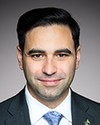Thank you very much, Mr. Chair and committee members. Good morning. Let me add my words of welcome and congratulations also to Minister Blair. We're very glad to have him as part of our team at Public Safety.
The border, Mr. Chair, that we share with the United States is the most successful international boundary in the history of the world. It is a source of great prosperity for both our countries, with 400,000 people and $2.5 billion in trade crossing in both directions every day. This immense flow of trade and travel happens at the same time that security, of course, remains our top priority when it comes to border management. From the very beginning of the asylum-seeker issue about 18 months ago, the Government of Canada has repeatedly emphasized two primary objectives: make sure that all Canadian laws are enforced, and make sure that all of Canada's international obligations are honoured. We have met those imperatives, Mr. Chair, without fail and we will continue to do so, ensuring public safety and national security.
We can all thank the competent officers responsible for law enforcement and border security for that. They enforce Canada's laws while ensuring we meet our international obligations. Both for them and for our government, security remains the number one priority.
Our law enforcement and border security personnel have been performing their duties in a professional and highly effective manner during what has been a busy and challenging time. Everyone who has seen them in action at the border, at places like Lacolle, have nothing but praise and admiration for their work, including, I am pleased to say, the leader of the official opposition, who paid a visit to the border at Lacolle some weeks ago.
We have repeatedly made clear that entering Canada outside an official port of entry is not a free ticket to stay here. There are rules and procedures that must be followed—notably, the Immigration and Refugee Protection Act and the Criminal Code. The women and men of the Canada Border Services Agency, the RCMP, and the Department of Immigration, Refugees and Citizenship apply those rules and procedures assiduously. Those who cross the border between ports of entry are immediately arrested. They are carefully interviewed, searched, fingerprinted, and photographed. Their identity is verified both biographically and biometrically. Their records are checked against Canadian and international databases for any immigration, security, or criminal concerns. If they present any risk to the safety and security of Canadians, they can be detained as necessary.
Asylum seekers who are found eligible to pursue an asylum claim in Canada are issued a conditional removal order pending the resolution of their claim by the Immigration and Refugee Board. That is a question of fact that they must prove. If the IRB finds that an individual is in genuine need of Canada's protection, they receive that protection in keeping with our values and our long-standing international commitments. If the claim is unsuccessful, the claimant becomes inadmissible to Canada, and the removal process proceeds as quickly as possible in accordance with the due process of law.
That is the process, because since Canada signed on to the UN refugee convention nearly half a century ago, it has been one of our country's bedrock principles that we do give a fair hearing to people on our soil who ask for our protection. That principle is embodied in section 133 of the Immigration and Refugee Protection Act.
At the same time, our system must be well managed. That's why earlier this year the government operations centre within my department led Canada's contingency planning for a possible surge in irregular migration this summer. In fact, the number of asylum seekers crossing between ports of entry went down in May, and it went down again in June, now to the lowest monthly total so far in 2018. But thanks to our preparations as well as continued collaboration with provincial and municipal partners, we have a national strategic response plan that is now in effect. This plan is based on lessons learned and best practices from our experiences collectively last year. It enables us to use all of the resources—technology, intelligence, and partnerships—available to address fluctuations in irregular migration. It is flexible and nimble, and allows for quick responses when necessary, including increases and decreases in capacity based on need.
These measures are bolstered by the additional funding provided in budget 2018. Within the public safety portfolio, that includes $49 million for CBSA, $10 million for the RCMP, and $2 million for CSIS. On top of that there are, of course, regular communications with U.S. authorities. I raised this matter of irregular migration, for example, at the G7 security ministers meeting in Toronto in April, where American officials undertook to strengthen efforts on their part to prevent the abuse of U.S. travel documents. That have in fact done that.
All of this taken together is ensuring effective, responsible management of the situation at our border.
I'll conclude with this. Irregular migration is an issue that countries around the world are dealing with. We should not be surprised that it's affecting Canada too, and we should not expect there to be easy, quick solutions to what is a complex global problem. But Canadians can be assured that robust security measures are in place, that Canadian law is being rigorously applied, and that we are living up to our international obligations and to our duties and values as Canadians.
Mr. Chair, let me now invite my colleague Minister Blair to go ahead.






